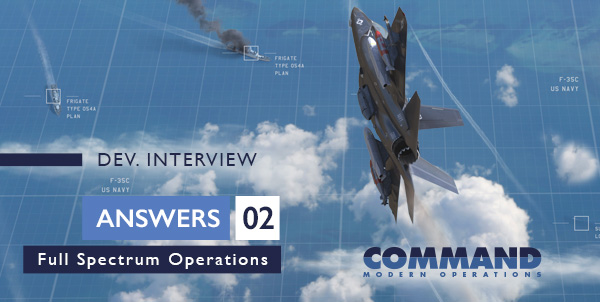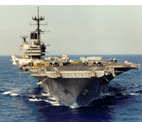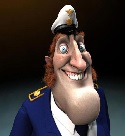Daniele
Posts: 1812
Joined: 2/7/2015
Status: offline

|
The first part of the C: MO Developer Interview dealt with the integration of new software and feature into Command: Modern Operations. Thanks to new terrain layers, new global satellite imagery and 3D vision provided by Tacview (among many other tools) the whole gameplay experience has been greatly improved.
This Second Part, called "Full Spectrum Operations", goes further in detail in exploring how the Battlefield Control has been expanded in all sectors of modern warfare.

5) Speaking of new terrain types, we noticed that the announcement references improvements in ground operations. We also saw some screenshots with high-res maps with roads and similar infrastructures. Can you elaborate on what’s in store for digital grunts in CMO?
The answer to this first requires, I think, a prologue of sorts.
People sometimes ask us (or wonder aloud) on public fora “when will CMANO get ground ops”. I think this question starts off on the wrong foot. Who is the arbiter of this? What are the criteria? Command v1.x already has ground ops, limited as they are. Call of Duty has ground ops. Medal of Honor has ground ops. Even Quake and Halo and Unreal Tournament have some basic ground ops (people run on foot or in vehicles and shoot at each other, no?). The point being, ground ops are not a binary “have / don’t have” black-or-white thing. There are shades of gray. There are degrees.
It’s possible to put together an excellent game centered on ground forces while ignoring huge chunks of what makes ground ops work in real life. Some examples easily spring to mind. Where are logistics, attrition replacements, political factors/events, theater intelligence and TBMs in Armored Brigade? It doesn’t need them, because it’s a tactical game and a superb one. Where is the detailed nuts-and-bolts ground combat in TOAW? It doesn’t need it, because it’s an excellent operational/theater game. So the threshold for considering a game as “having ground ops” is not “it has feature-XYZ that I personally deem essential”, but instead “it has the features necessary to model the aspects of ground warfare that it aims to model”.
Command has always viewed ground forces as another element in joint & cross-domain operations, with a primary focus on how they interact with air, naval & strategic assets. This focus remains dominant in CMO. I know it has become something of a cliche to view ground units in CMANO as “just there for ships and aircraft to shoot at”, but these are nothing like ducks in a shooting gallery: these ducks can wreck your fleet, wipe out your airforce both in the air and on the ground (the old NATO grim joke “the best Russian air superiority fighter is a tank sitting on the runway at Bitburg & Ramstein” is ever so true in Command) and of course also clash among themselves.
Now, to the actual question. The CMANO Mega-FAQ on our site already explains the main features and limitations of the ground ops as modelled in CMANO v1.x, so we don’t need to repeat it here. So instead let’s jump directly to the key improvements we have put together on this aspect in CMO:
A major new feature is that now the virtual terrain is not a “global barren desert”: Terrain type (urban, desert, forest, grassland, snow etc.) now critically affect the ground units moving through them. They affect a unit’s movement speed, its vulnerability to different weapon and warhead types, and its detectability to different sensor types. For example thick forests make it much harder to detect a ground unit both visually and by radar, and they also drastically reduce the effective damage radius of explosive and fragmentation warheads (but not napalm and FAEs - and now you realize why these were the archetypal A2G munitions in Vietnam). Urban areas also curtail sensor performance but their excellent road network offers big mobility bonuses. So if you want to hide a ground unit, or park a unit in an area where it can rapidly move around to respond to threats, you can now use the terrain toy your advantage. If you are curious about why and how the Iraqi army was obliterated in the open desert while the Serbian army emerged from the mountainous forests of Kosovo only lightly damaged after NATO threw the kitchen sink at them, Command can now show you.
Concurrently, ground forces are now a lot smarter about their navigation. They will intelligently pick the most optimum route to get to their destination as soon as possible, taking into account both terrain slope and terrain type. (To answer a frequent question that has popped up since we published the first screenshots: No, roads are currently only a visible element, they are not recognized and exploited by ground forces. That’s a future addition).
The UNREP logics are now also implemented for mobile land units. So now it is possible to load up munitions on supply trucks, and have front-line forces race back to them for resupply if they run low on ammo (fuel is still considered infinite for land forces). This resolves one of the biggest limitations of the CMANo v1.x ground ops and adds an extra dimension to the conduct of battle.
6) Let’s talk a bit about the naval component. What do you think is the most innovative feature that will be added, or the most significant improvement from CMANO?
One seemingly small thing that we think will be quite liked is how ship icons, in “Directional” display mode, can scale to their actual dimensions when zoomed in. See this example:

Some other useful additions:
Patrol missions can now have two different movement styles: The traditional “random movement within defined area”, and a racetrack pattern similar to how support missions are followed. This allows you to define precise patrol coverage patterns.
Surface- and underwater-launched missiles now use the same improved pitch kinematics as air-launched missiles (ie. smoother climbs/dives).
IR and visual sensors can now generate precise detections only at short ranges.
7) Could you tell us a little more about what do you mean exactly by “realistic submarine comms”?
One of the decisions that we made during CMO’s development was that the handful of features hitherto unlockable only by “Chains Of War” and some of the other DLCs (comms disruption, detailed aircraft damage, cargo/landing/airdrop operations and advanced weapon types) will now be available as standard. This has the dual benefit of freeing scenario designers to use these features without restraint (e.g. no longer necessary to make COW and no-COW versions of a scenario, as we have sometimes observed), and also allowing us to use these mechanics as the foundation for additional simulation features. Realistic submarine communications is such an example, as it builds on top of comms disruption.
When this feature is enabled (it is disabled by default, to avoid breaking existing scenarios), submarines that go deeper than shallow depth go “off grid” and are no longer be visible or accessible to the player. They are still in control of themselves and if appropriately tasked they will pursue their assigned mission to their fullest.
The player can wait for the subs to rejoin or can deliberately summon them through a “bell-ringer” signal (typically an ELF/VLF transmission in real life) that calls their attention. When/if they come up to shallow or periscope depth (they may remain below in order to avoid hostile encounters), they re-establish communications. At that point they share with their parent side any new contacts they have established and become again under positive control.
8) Beside naval, Air warfare has always been the other major focus in CMANO. Will C:MO players see differences in managing squadrons, targets, aircraft behavior and missions in general?
Mission logic is largely carried over from its present state in CMANO v1.x . There are, however, quite a few new additions in UI and sim mechanics that should prove quite popular. Among them:
You can now use the formation editor also for airgroups, and arrange the wingmen to your liking. A suitably managed aircraft formation can defeat both superior weaponry and even higher individual proficiency (no amount of Maverik hotdogging will save you if the enemy lead and wingman cooperate well to nail you)
A popular request: Range ring depicting the selected aircraft’s remaining flying range. It is dynamically adjusted based on the current fuel consumption and speed. This can be quite useful in quickly visualizing targets (and recovery airfields) within reach.
Numerous tweaks to aircraft flight model, specifically for "combat" conditions. For example, aircraft no longer "wiggle" between headings as they must first roll towards the turn direction before commiting to a turn. This in turn makes roll-rate much more critical to close air combat maneuvers. This is easier to observe in the Tacview window.
New radar model factor: Frequency agility. Frequency-agile radars get two major benefits; they are more resistant to noise jamming and they are significantly less affected by doppler notching (see below). Mechanical-scan radars that are frequency agile have this flag on their DB values. (This feature is so important operationally that many “export” radar sets basically comprise of the base model with the frequency-agility functionality disabled or altogether removed.) All PESA and AESA radars are assumed to be frequency-agile.
Doppler notching is now actively used as a maneuver, both for missile avoidance and for general radar detection avoidance. Aircraft can attempt to fly perpendicular to an emitter using doppler filtering in order to hige inside its "blind" velocity gate. The effectiveness of the maneuver varies with crew skill (an "ace" pilot will execute it far more effectively than a novice), to discourage manual micromanagement. Aircraft under missile attack with a doppler radar guiding the missile will also actively try to beam the radar instead of the missile (the geometry of the two axes can vary significantly). The maneuver is ineffective against pulse-only radars and less effective against frequency-agile radars. Players can also deliberately plot courses for aircraft that fly perpendicular to known PD search radars, to reduce the actual detection range. (If you’re a Microprose F-19/F-117 virtual vet this may bring back some memories).
Air combat AI improvement: Aircraft now consider approaching fighters/interceptors as imminent threat, not just missiles. This helps AI-controlled aircraft perform more proactive evasive maneuvers against fighters about to perform gun attacks on them (e.g. MiG-17 vs F-105).
9) In the public Feature list, there is a mention on “Aircraft crew G-tolerance”. Could you elaborate this point a bit more?
In CMANO v1.x, one of the limitations of the close air combat model is that similarly-manouverable aircraft may find themselves into an “endless” tight-turning fight (until someone runs out of weapons or fuel first, anyway). In real-world engagements this is not possible because the human body can endure strong G-forces only for a few seconds at most. So we set out to model this with this new feature.
When aircraft now engage in a turning fight, the simulation actually keeps track of the G-strain accumulated on each plane’s crew. When the tolerance limit is exceeded, the crew has to relax their turn in order to avoid losing consciousness and ultimately losing control of the aircraft. This reduces the strain on the crew and after a few seconds it will be able to maneuver hard again. Naturally, this makes the aircraft very vulnerable to attacks in that timespan and further emphasises proper cooperative team tactics.
The tolerance to G-strain varies with proficiency level (practice and experience help a lot), so vets and aces have one more advantage against greener opponents.
PART III QUESTIONS: INFORMATION MANAGEMENT AND FUTURE PLANS
10) We can assume that AI will play a key role in C: MO, given that multiplayer won’t be added at release. Could you give us more details on how the AI has been improved?
11) The amount of information available in CMANO has always been massively daunting. What solutions have been taken in C:MO to help new players in not being overwhelmed?
12) On a side topic, could you confirm there are plans to integrate Steam Workshop with C:MO? Will the modding process will be altered in some significant way?
13) Is there a feature or mechanic that you would have loved to have at release but had to drop?
14) We are sure that your commitment with this project won’t stop just with the release of C:MO. Any glimpse of future plans? Are you planning a new take with DLCs and expansions?
< Message edited by Daniele -- 9/25/2019 9:51:34 AM >
|
 Printable Version
Printable Version

















 New Messages
New Messages No New Messages
No New Messages Hot Topic w/ New Messages
Hot Topic w/ New Messages Hot Topic w/o New Messages
Hot Topic w/o New Messages Locked w/ New Messages
Locked w/ New Messages Locked w/o New Messages
Locked w/o New Messages Post New Thread
Post New Thread